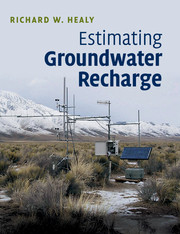Book contents
- Frontmatter
- Contents
- Preface
- Acknowledgments
- 1 Groundwater recharge
- 2 Water-budget methods
- 3 Modeling methods
- 4 Methods based on surface-water data
- 5 Physical methods: unsaturated zone
- 6 Physical methods: saturated zone
- 7 Chemical tracer methods
- 8 Heat tracer methods
- 9 Linking estimation methods to conceptual models of groundwater recharge
- References
- Index
1 - Groundwater recharge
Published online by Cambridge University Press: 05 April 2013
- Frontmatter
- Contents
- Preface
- Acknowledgments
- 1 Groundwater recharge
- 2 Water-budget methods
- 3 Modeling methods
- 4 Methods based on surface-water data
- 5 Physical methods: unsaturated zone
- 6 Physical methods: saturated zone
- 7 Chemical tracer methods
- 8 Heat tracer methods
- 9 Linking estimation methods to conceptual models of groundwater recharge
- References
- Index
Summary
Introduction
Groundwater is a critical source of fresh water throughout the world. Comprehensive statistics on groundwater abstraction and use are not available, but it is estimated that more than 1.5 billion people worldwide rely on groundwater for potable water (Clarke et al., 1996). Other than water stored in icecaps and glaciers, groundwater accounts for approximately 97% of fresh water on Earth (Nace, 1967; Shiklomanov and Rodda, 2003). As the world population continues to grow, more people will come to rely on groundwater sources, particularly in arid and semiarid areas (Simmers, 1990). Long-term availability of groundwater supplies for burgeoning populations can be ensured only if effective management schemes are developed and put into practice. Quantification of natural rates of groundwater recharge (i.e. the rates at which aquifer waters are replenished) is imperative for efficient groundwater management (Simmers, 1990). Although it is one of the most important components in groundwater studies, recharge is also one of the least understood, largely because recharge rates vary widely in space and time, and rates are difficult to directly measure.
The rate, timing, and location of recharge are important issues in areas of groundwater contamination as well as groundwater supply. In general, the likelihood for contaminant movement to the water table increases as the rate of recharge increases. Areas of high recharge are often equated with areas of high aquifer vulnerability to contamination (ASTM, 2008; US National Research Council, 1993). Locations for subsurface waste-disposal facilities often are selected on the basis of relative rates of recharge, with ideal locations being those with low aquifer vulnerability so as to minimize the amount of moving water coming into contact with waste (e.g. US Nuclear Regulatory Commission, 1993). A high profile example of the importance of susceptibility to contamination is the study for the proposed high-level radioactive-waste repository at Yucca Mountain, Nevada. Tens of millions of dollars were invested over the course of two decades in efforts to determine recharge rates at the site (Flint et al., 2001a).
- Type
- Chapter
- Information
- Estimating Groundwater Recharge , pp. 1 - 14Publisher: Cambridge University PressPrint publication year: 2010
- 3
- Cited by



